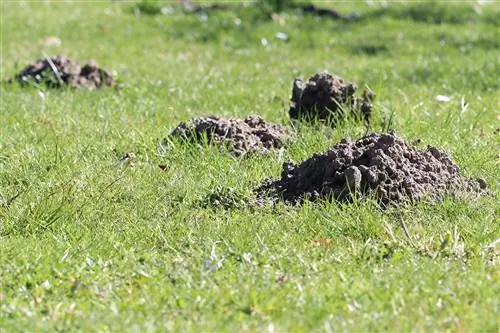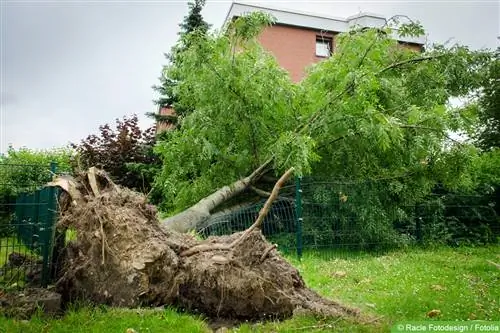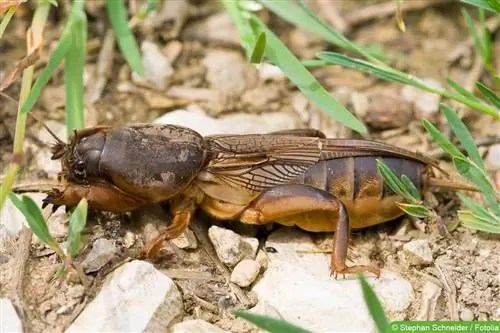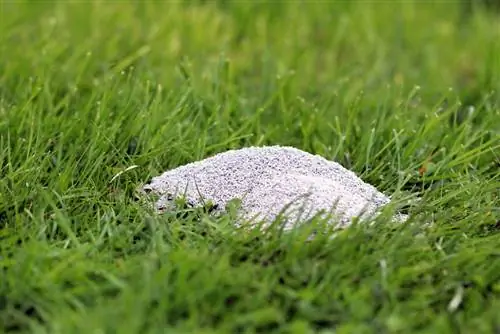- Author admin [email protected].
- Public 2023-12-17 03:39.
- Last modified 2025-01-24 12:45.
Opinions differ when it comes to moles. For some they are pests, for others they are useful animals that have great importance for the ecosystem of a garden.
Mole as a pest
Most people only know the animals through the mounds of earth that they throw up at regular intervals in an otherwise very well-kept lawn. These proverbial molehills have different functions in the lives of animals. They serve them
- as sleeping places
- as nests for their young
- as pantries or pantries
- as exit points of a corridor system
- as air supply for the underground passages
So moles don't throw up these mounds to annoy the lawn owner, but because it's simply in their nature and part of their way of life.
Note:
Since moles are committed solitary creatures, multiple mounds in the lawn are not evidence of multiple animals. Rather, only one of the underground excavation specialists is likely to settle in the meadow, who simply uses the hills for different purposes.
Of course the hills and the mole tunnels beneath them are still annoying. With them you can't think of a sensible and well-maintained lawn. It also involves a lot of work for the garden owner. Holes in the ground must be closed again and then sown again with grass seeds. This is of course annoying and also costs money. So it's no wonder that many garden owners see moles as uninvited guests and consider them pests. He finds the animals extremely annoying and sees them as no benefit for himself or his garden.
Mole as a nuisance
If you are honest, you have to admit that moles sometimes disturb our aesthetic sense with their mounds, but otherwise they do no harm.
Note:
An animal or, in general, an organism that does not cause any harm but is perceived as an enormous nuisance by people is called a so-called nuisance.
It's certainly not wrong to put moles in the category of nuisances - if only because their behavior can really annoy you. This also explains why garden owners often spend a lot of time and money to combat this pest sustainably or to drive it out of their own garden. It's better to leave it alone that this is often a wasted effort. As is so often the case, troublemakers can also be seen in a completely different way. All you have to do is change your perspective a little and you will immediately see that moles are incredibly useful animals that every garden can benefit from.
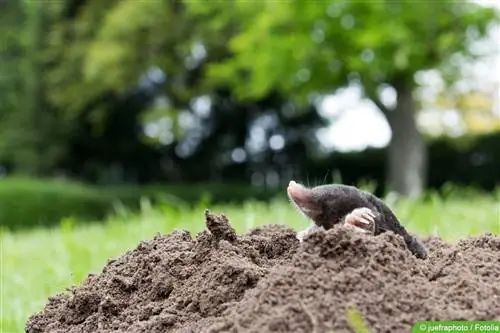
Mole as a beneficial insect
You can also see it that way. Talpa europaea, the Latin name for the mole, is a clear indication that the ecosystem of a garden is he althy and in balance. In the vast majority of cases, the animals only settle in places where the living and feeding conditions are right for them. As is well known, moles do not eat plants, but primarily feed on
- Earthworms
- Snails
- Caterpillars
- various larvae
- Snails
Having these animals in the ground is a sure sign that the ecosystem there is in order. So you can definitely see it as positive news. By the way, moles do not pose a real threat to the earthworm population in the garden. Because:
- Earthworms usually reproduce very quickly
- Moles also only eat part of the brood
- they don't endanger their existence out of their own interest
Fighting voles
Moles, which have no interest in the vegetables grown, can also be used to combat voles, which thrive on vegetable plants and fruits such as
- Celery
- Carrots
- Strawberries
- Onions
interested. Voles also pose a threat to the roots of flowers and trees that should not be underestimated. Roses in particular can suffer significantly from them. Talpa europaea can prevent a vole infestation in the garden and thus considerable damage, as young voles in particular are among moles' prey and are very fond of being eaten by them.
Useful helpers when gardening
Moles not only keep insects and voles in balance, but also prove to be very useful garden inhabitants in another way. They help ensure that loose soil is always available. They not only dig their burrows with their shovel-like front paws, but also literally sift through the earth with them. This digging work alone guarantees a loose soil that the plants can also enjoy. You can also save yourself the use of heavy equipment, as work like
- scarify
- ventilate
- raking
- digging
are no longer necessary but can be done by Talpa europaea. This is a big advantage because the animals repeat this work every year.
It is therefore good to see not only the bad sides of moles, but also the good ones.
Tip:
Seek peaceful coexistence with the garden mole and benefit from its positive properties.

